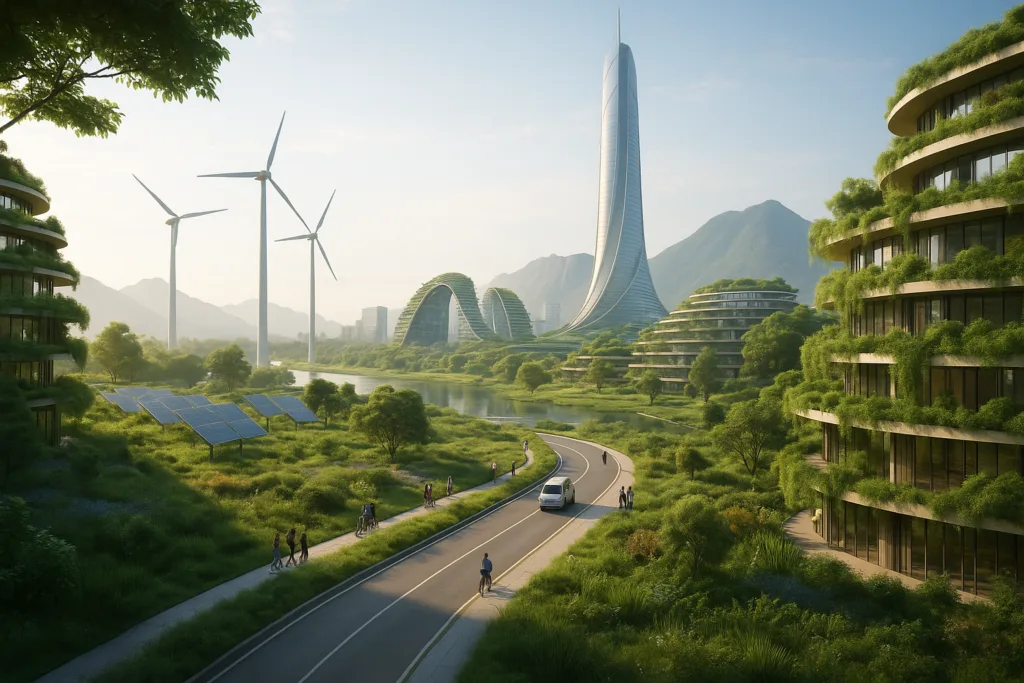The Earth is changing. Ice caps are melting, wildfires are becoming increasingly intense, and species are disappearing at an alarming rate. We have entered an era where environmental issues no longer exist in isolation; they intersect with health, economy, education, and social justice. As humanity confronts these crises, the future of environmental action is being reshaped with innovation, global cooperation, and a renewed sense of urgency. In this article, we explore how upcoming activities and initiatives across technology, cities, agriculture, conservation, and education will define our environmental trajectory over the coming decades.
Smart Cities and Sustainable Urban Development
More than half of the world’s population resides in cities, and by 2050, this number is projected to exceed 68%. This urban expansion presents both challenges and opportunities. Future environmental efforts will prioritize innovative, sustainable city models that reduce carbon footprints and foster healthier, more equitable urban living.
Cities will increasingly feature green architecture, including energy-efficient buildings with living walls and rooftops. Transportation systems will pivot toward electric and hydrogen-powered public transit, bike highways, and pedestrian-first urban planning. Waste will be minimized through advanced recycling systems, waste-to-energy plants, and a circular economy approach that keeps materials in use far longer than today.
Smart grids will manage energy consumption intelligently, balancing demand and supply while integrating renewable energy sources, such as solar, wind, and hydroelectric. These technologies, combined with community-driven initiatives such as urban gardens and green rooftops, will transform urban life into a model of environmental harmony.
Renewable Energy and the End of Fossil Fuels
The shift from fossil fuels to clean, renewable energy is essential for meeting global climate goals. Over the next few decades, expect a significant acceleration in the deployment of solar panels, wind turbines, geothermal stations, and next-generation nuclear energy.
Energy storage will become a cornerstone of this transition. New battery technologies, including solid-state batteries and grid-scale energy banks, will help store power from intermittent sources like wind and solar. Hydrogen fuel, once considered too volatile or expensive, is rapidly becoming a viable alternative for sectors such as aviation, heavy industry, and long-haul transport.
Decentralized power generation will allow communities and even individual households to become energy producers, feeding surplus electricity back into the grid. This democratization of energy not only reduces emissions but also empowers people economically.
Regenerative Agriculture and Food Security
Agriculture accounts for a large share of global greenhouse gas emissions, but it also holds one of the greatest potentials for environmental recovery. The future of farming lies in regenerative practices that restore the land rather than deplete it.
These practices include crop rotation, cover cropping, composting, reduced tillage, and agroforestry. Advanced technologies, such as AI, satellite imaging, and soil sensors, will guide precision farming, reducing the need for water, fertilizers, and pesticides. Urban agriculture, including vertical farms and aquaponics systems, will bring food production closer to consumers while minimizing land use and environmental impact.
Lab-grown meat and plant-based protein innovations will drastically reduce the environmental impact of livestock farming. These developments are key to building a food system that is resilient, equitable, and low-carbon.
Ocean Restoration and Plastic Alternatives
Our oceans are in crisis. Overfishing, acidification, rising temperatures, and plastic pollution are all threats to marine life. The future of environmental action includes a strong emphasis on restoring ocean ecosystems.
Massive ocean cleanup initiatives, including the use of autonomous drones and floating barriers, are already underway to collect plastic waste. Beyond cleanup, the focus is shifting to prevention. Biodegradable and reusable materials are replacing single-use plastics, and new legislation across continents is banning or taxing plastic packaging.
Marine protected areas (MPAs) will expand significantly, creating sanctuaries for endangered species and helping restore coral reefs and fish stocks. Innovations in ocean farming, such as kelp cultivation, will offer sustainable alternatives for food and biofuel while also absorbing carbon from the atmosphere.
Conservation and Rewilding
Rewilding is an emerging conservation approach that aims to restore ecosystems to their natural state, allowing native species and processes to reestablish themselves with minimal human intervention.
Large-scale rewilding projects across Europe, North America, and parts of Asia are already showing results—bringing back apex predators like wolves and lynx, reintroducing beavers to manage water systems, and revitalizing landscapes. In the future, these initiatives will be backed by drones for aerial seeding, AI for wildlife tracking, and satellite data to monitor ecological recovery.
These conservation efforts will be crucial for maintaining biodiversity, sequestering carbon, and building resilience against climate impacts such as floods and droughts.
Eco-Education and Youth Empowerment
The next generation is both the most affected by environmental decline and the most powerful voice for change. Future environmental strategies will embed climate education into school curriculums globally.
Students will learn not only about recycling and conservation but about climate science, environmental justice, and sustainable economics. Experiential learning through nature excursions, citizen science, and community projects will nurture a deep connection with the natural world.
Tech-enabled tools, such as virtual reality, will enable immersive experiences of coral reefs, rainforests, or Arctic landscapes, even from urban classrooms. Empowering youth with knowledge and tools will ensure that they not only inherit the Earth but are also equipped to protect and improve it.
Environmental Justice and Global Equity
Environmental degradation often hits the poorest and most marginalized communities the hardest. Future environmental action must prioritize equity, ensuring that the benefits of sustainability are shared equally among all.
This includes providing access to clean water, clean energy, and healthy environments for underserved populations. It also means involving indigenous communities in land and forest management, recognizing their traditional knowledge and rights.
Global cooperation, facilitated through agreements like the Paris Climate Accord, will be crucial. But beyond policy, grassroots activism, community-driven solutions, and financial investment in vulnerable areas will drive real, lasting change.
Conclusion: Building the Future Today
The future of the environment isn’t an abstract concept—it is being built right now. Each innovation, each act of conservation, and each choice to reduce, reuse, or rethink consumption patterns is a brick in the foundation of a better tomorrow.
We are on the brink of a green transformation. With vision, unity, and courage, the world can pivot from crisis to opportunity, from damage to restoration. The future depends on us—and that future starts today.
FAQs
Q1: What are the most promising technologies for future environmental action?
A: Renewable energy innovations (solar, wind, hydrogen), innovative grid systems, precision agriculture, biodegradable materials, ocean-cleaning tech, and carbon capture are among the most promising.
Q2: How can cities reduce their environmental impact in the future?
A: By adopting smart infrastructure, clean public transport, green building standards, efficient waste systems, and promoting walkable, bike-friendly designs.
Q3: What role does education play in future environmental sustainability?
A: Education builds awareness and skills. Climate literacy, hands-on sustainability projects, and youth empowerment are key to long-term environmental stewardship.
Q4: Can individuals make a difference in solving global environmental problems?
A: Yes. Collective individual actions shape markets and influence policy. Choices around diet, energy use, transportation, and voting matter greatly.
Q5: What is the timeline for these future activities to become mainstream?
A: Many are already underway. By 2030, we can expect to see significant shifts in energy, food, and transportation. By 2050, sustainability will likely be embedded in nearly all aspects of life.
Q6: How can governments support future environmental initiatives?
A: Through policy incentives, subsidies for green technology, strict pollution controls, climate education programs, and international cooperation on climate goals.


